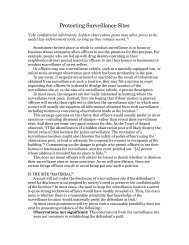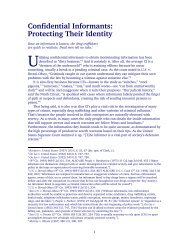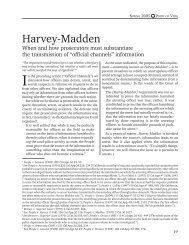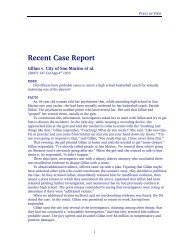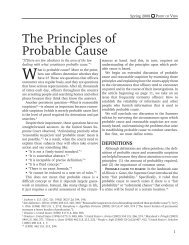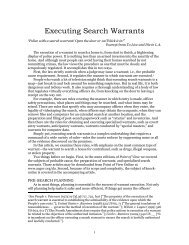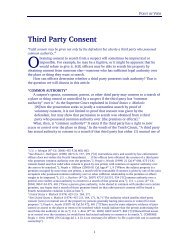PC TO ARREST.pmd - Alameda County District Attorney's Office
PC TO ARREST.pmd - Alameda County District Attorney's Office
PC TO ARREST.pmd - Alameda County District Attorney's Office
You also want an ePaper? Increase the reach of your titles
YUMPU automatically turns print PDFs into web optimized ePapers that Google loves.
ALAMEDA COUNTY DISTRICT AT<strong>TO</strong>RNEY’S OFFICE<br />
A suspect’s obvious attempt to ignore officers or<br />
pretend that he did not see them may also be somewhat<br />
suspicious. 137 The fact that the suspect reacted<br />
by making, or failing to make, eye contact with an<br />
officer is, if anything, only marginally relevant. 138<br />
“Suspicious” Activity<br />
<strong>Office</strong>rs sometimes see people doing things that,<br />
although not illegal, are suspicious. As the Court of<br />
Appeal observed, “Experienced police officers naturally<br />
develop an ability to perceive the unusual and<br />
suspicious which is of enormous value in the difficult<br />
task of protecting the security and safety of lawabiding<br />
citizens.” 139<br />
The courts will not, however, uphold a detention<br />
merely because an officer testified that the<br />
defendant’s actions were “unusual” or “suspicious.”<br />
Instead, they need to know exactly what he did and<br />
why it appeared significant. 140<br />
EXCESSIVE LOOKING AROUND: People who are committing<br />
a crime, or who are about to, tend to look<br />
around a lot to see if anyone is watching. This is<br />
especially true of drug dealers. As the court noted in<br />
Flores v. Superior Court, “Those involved in the narcotics<br />
trade are a skittish group—literally hunted<br />
animals to whom everyone is an enemy until proven<br />
to the contrary.” 141 Consequently, activities such as<br />
the following have been considered noteworthy:<br />
12<br />
� A suspected drug dealer “scouted the area before<br />
entering the apartment.” 142<br />
� The suspect “loitered about” and “looked furtively<br />
in all directions.” 143<br />
� The suspect “alighted from the vehicle and looked<br />
around apprehensively for quite some period of<br />
time.” 144<br />
� Two men who had just left a jewelry store (after<br />
robbing it) kept looking back at the store. 145<br />
Note, however, that because many innocent people<br />
are “skittish,” or at least vigilant, a suspect’s watchfulness<br />
ordinarily becomes a factor only in light of<br />
the surrounding circumstances.<br />
COUNTERSURVEILLANCE: Another common activity<br />
of vigilant criminals is countersurveillance, which<br />
generally consists of tactics that make it difficult for<br />
officers to follow them, or that force the officers to<br />
engage in detectable surveillance. 146<br />
For example, the Court of Appeal has noted that<br />
countersurveillance driving tactics “typically include<br />
driving slowly at less than the flow of traffic, making<br />
sudden and unsignaled changes in velocity and<br />
direction, as well as ‘running’ red traffic lights. Each<br />
of these tactics is designed to make unobserved<br />
surveillance very difficult.” 147 Some examples:<br />
� “The Lexus went to two addresses which the<br />
officers associated with drugs, and drove in and<br />
out of the parking lots of those buildings several<br />
times.” 148<br />
137 See United States v. Arvizu (2002) 534 U.S. 266, 270 [driver, as he passed a patrol car, “appeared stiff and his posture very rigid.<br />
He did not look at [the officer] and seemed to be trying to pretend that [the officer] was not there.”].<br />
138 th See U.S. v. Montero-Camargo (9 Cir. 2000) 208 F.3d 1122, 1136 [“The skepticism with which [the eye-contact] factor is treated<br />
is in large part due to the fact that reliance upon ‘suspicious’ looks can so easily devolve into a case of damned if you do, equally<br />
damned if you don’t.”].<br />
139 People v. Elisabeth H. (1971) 20 Cal.App.3d 323, 327.<br />
140 See Brown v. Texas (1979) 443 U.S. 47, 52 [“[The officer] testified at appellant’s trial that the situation in the alley ‘looked suspicious,’<br />
but he was unable to point to any facts supporting that conclusion.”].<br />
141 (1971) 17 Cal.App.3d 219, 223.<br />
142 th People v. Avalos (1996) 47 Cal.App.4 1569, 1577.<br />
143 th People v. Carrillo (1995) 37 Cal.App.4 1662, 1668.<br />
144 People v. Moore (1970) 13 Cal.App.3d 424, 431.<br />
145 People v. Dolliver (1986) 181 Cal.App.3d 49.<br />
146 See People v. McNabb (1991) 228 Cal.App.3d 462, 466 [“the conduct of suspect 3 was consistent with countersurveillance to make<br />
sure the police were not watching”]; U.S. v. Del Vizo (9th Cir. 1990) 918 F.2d 821, 826 [the suspects “frequently appeared to check<br />
whether they were being followed . . . all the while traveling in a counter-surveillance fashion”]; U.S. v. Chavez-Miranda (9th Cir. 2002)<br />
306 F.3d 973, 978 [“[The suspect] employed counter-surveillance driving techniques, which we have recognized as being indicative<br />
of narcotics distribution.”]; U.S. v. Ocampo (9th Cir. 1991) 927 F.2d 485, 490 [“[C]ounter-surveillance driving [is] indicative of<br />
narcotics distribution.”]; People v. Carvajal (1988) 202 Cal.App.3d 487, 496 [the suspect “drove his truck in a highly unusual,<br />
apparently evasive manner immediately following the retrieval of several large, heavy boxes from a storage facility”].<br />
147 th People v. $497,590 (1997) 58 Cal.App.4 145, 148.<br />
148 th U.S. v. Johnson (8 Cir. 1995) 64 F.3d 1120, 1125.



